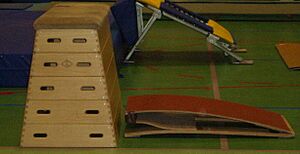Springboard (gymnastics) facts for kids

A springboard is a special platform with springs. Gymnasts use it to jump higher and further than they could from a regular floor. It's a super important tool in artistic gymnastics! You'll see springboards used a lot in the vault event. They also help gymnasts start routines on other equipment, like the balance beam or uneven bars, by giving them a boost to get onto the apparatus. A typical springboard is about 2 feet (0.6 m) wide and 4 feet (1.2 m) long.
The History of Springboards
How Reuther Boards Changed Gymnastics
The idea for a new kind of springboard started in the 1930s. A clever inventor named Richard Reuther created what became known as 'Reuther boards'. These special boards helped gymnasts get even more speed and height when they performed vaults. This was a big step forward for the sport!
The 1956 Summer Olympics were the first time these new Reuther boards were used in competition. For a while, different competitions used different types of boards. Some used the newer springboards, while others still preferred Reuther boards. For example, the 1991 World Artistic Gymnastics Championships used springboards. But then, the 1992 Summer Olympics went back to using Reuther boards. Eventually, springboards with actual springs became the standard.
Choosing the Right Springboard
Today, at big gymnastics competitions, gymnasts can choose between two main types of springboards: a 'hard' board and a 'soft' board. This choice helps them perform their best!
For the exciting vault event, gymnasts can pick either the hard or the soft board. However, for other events where a springboard might be used, like getting onto the balance beam, they can only choose the soft board. This rule helps keep things fair and safe for everyone.



